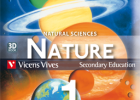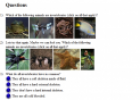The Animal Kingdom (I). Invertebrates
Today our planet is home to a great variety of organisms. This is the result of an evolutionary process that began some 3.5 billion years ago. Invertebrates are a very diverse group of animals that do not have a spinal column. The main groups of invertebrates are sponges, cnidarians, flatworms, nematodes, annelids, molluscs, echinoderms and arthropods (insects, crustaceans, arachnids and myriapods). [...]
Esta secuencia contiene:
-
12 actividades
-
103 recursos
-
Idioma:
- Inglés
-
Formato:
Interactivo
Secuencia didáctica
-
Didactic objectives Understand and differentiate invertebrate groups studied in this topic through theirmorphological characteristics Acquire an overview of the animal kingdom and its classification, highlighting the diversityand abundance of spec...
-
1. The simplest invertebrates The most common invertebrates are sponges, cnidarians, flatworms, nematodes, annelids, molluscs, echinoderms and arthropods. Sponges are aquatic animals. They act as filters and live fixed to rocks. [...]
-
Today our planet is home to a great variety of organisms. This is the result of an evolutionary process that began some 3.5 billion years ago. Invertebrates are a very diverse group of animals that do not have a spinal column. [...]
-
The most common invertebrates are sponges, cnidarians, flatworms, nematodes, annelids, molluscs, echinoderms and arthropods. 1.1. Poriferans or sponges Sponges are aquatic animals. They act as filters and live fixed to rocks. [...]
-
2.1. Nematodes Nematodes are thin, round, non-segmented worms. There are a large variety of free-living land nematode species, although they prefer wet environments. [...]
-
3.1. Echinoderms Echinoderms are animals that live at the bottom of the sea. They do not have a head. They have an external skeleton consisting of plates with spines. The majority of echinoderms have a five-point radial symmetry (pentaradial). [...]
-
4.1. Arthropods Arthropods are the most numerous and diverse group of invertebrates. They have adapted to all kinds of environments. The body of an arthropod has three parts: the head, thorax and abdomen. [...]
-
5.1. Crustaceans Crustaceans are a very large group of arthropods. They are mostly marine creatures. Their body is divided into the cephalothorax and abdomen. [...]
-
6.1. Insects The bodies of insects are divided into the head, thorax and abdomen. Insects have a pair of antennae and mouthparts on their head. The mouthparts are adapted to the different types of food the various insects eat. [...]
-
Insects began to fly about 240 million years ago. They are the only invertebrates that are able to fly. With wings, insects were able to spread to all different parts of the Earth, except the seas and oceans.
-
Today our planet is home to a great variety of organisms. This is the result of an evolutionary process that began some 3.5 billion years ago. Invertebrates are a very diverse group of animals that do not have a spinal column. [...]
-
Today our planet is home to a great variety of organisms. This is the result of an evolutionary process that began some 3.5 billion years ago. Invertebrates are a very diverse group of animals that do not have a spinal column. [...]
Cursos y asignaturas
-
12 años:
- Geologia
- Biología
-
13 años:
- Biología
- Geologia
-
Aún no hay comentarios, ¡comparte tu opinión! Inicia sesión o Únete a Tiching para poder comentar
La licencia digital es una autorización que permite utilizar un recurso digital de acuerdo con las condiciones legales de dicho recurso. El código que recibas una vez la hayas comprado te permitirá acceder al recurso educativo digital elegido.
Puedes consultar más información en nuestra página de ayuda.












































































































![These animals are invertebrates. [...] | Recurso educativo 463684](http://do.tiching.com/uploads/contents/2014/05/20/463684_1400538597_s.png)



¿Dónde quieres compartirlo?
¿Quieres copiar el enlace?